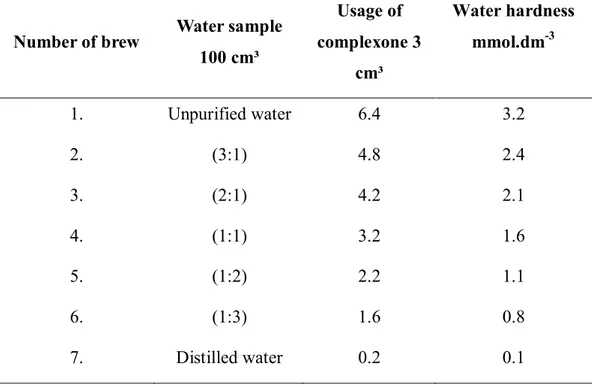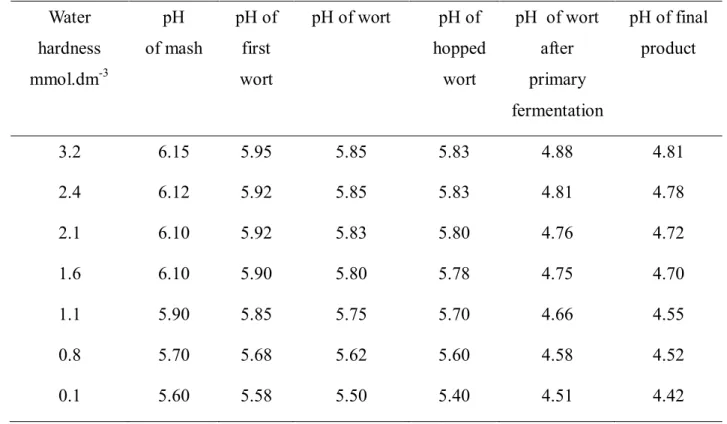REGULAR ARTICLE
WATER HARDNESS AS AN IMPORTANT PARAMETER OF PH
Žigmund Tóth*, Helena Frančáková, Miriam Solgajová, Štefan Dráb
Address: Ing. Žigmund Tóth PhD.
Slovak University of Agriculture, Faculty of Biotechnology and Food Sciences, Department of Storing and Plant Products Processing, Tr. A .Hlinku 2, 949 01, Nitra, Slovakia, phone
number: 037 654 4421.
*Corresponding author: zigmund.toth@uniag.sk
ABSTRACT
Keywords: water hardness, pH, mash, fisrt wort, wort, hopped wort, beer
INTRODUCTION
According to Basařová et al. (2010), amount of dissolved salts in water is a very important criteria used in practice for assessing the suitability of water for specific technological applications. In the past, the most used term for dissolved salts was the term "hardness", which is still commonly used in practice. It was either the sum of calcium, magnesium and barium ions, but also it was the amount of all cations with charge number greater than 1.
Poláček et al. (2010) states that it is more correct to express the content of calcium and
magnesium separately and not as its sum by using the term hardness, as their chemical, technological or biological properties are not the same. However, despite the objections of many chemists around the world the concept of hardness persists throughout the world, as it is a term used in the public and professional practice.
According to Šrogl (2000) in terms of hardness it is recognized: soft water: <1.3 mmol.dm-3, moderately hard water: from 1.3 to 2.5 mmol.dm-3, hard water: from 2.5 to 3.8
mmol.dm-3, very hard water: >3.8 mmol.dm-3.
Water for production of world-famous Pilsner type beer should be very soft with a predominance of carbonate hardness of 0.23 mmol.dm-3. Such water is used to produce light,
medium-fermented beers and bitter beers with a full taste (Basařová et al., 2011). During wort boiling with hops, hydrogen carbonates of alkalic metals alter by splitting off carbon dioxide to more or less soluble carbonates and this affects calcium-carbonate balance (Lewis et al., 2002).
Magnesium carbonate is a volatile, during prolonged boiling it breaks down and can be completely removed out of solution. Non-carbonate water hardness is formed by calcium and magnesium salts of sulphuric acid, hydrochloric acid, nitric acid, and others, that do not change during a boiling. Total and temporary hardness are determined analytically and permanent hardness is calculated from their difference (Basařová et al., 2011).
carbonate anions in the reactions running at high temperatures utilize hydrogen cations, reduce acidity and release carbon dioxide. The acid reaction of mash during boiling process ensure dissociated dihydrogen phosphates (H2PO4-), hydrogen phosphates (HPO42-) and
phosphates (PO4-) of malt. The first phosphates show acid reaction, the second weakly alkalic
reaction and the third alkalic reaction.
According to Basařová et al. (2010) calcium cations may be present in water at high concentrations (up to 200 mg.dm-3), they stimulates the activity of certain malt enzymes,
especially those that support the stability of the α-amylase by its protection against thermal denaturation, but they also promote the activity of endopeptidases.
Bamforth (2003) also claims that calcium promotes α-amylase activity, which then
reacts with phosphates in malt, which leads to a reduction of pH to an appropriate level for boiling. Polacek et al. (2010) adds that calcium promotes protein coagulation, it stimulates the activity of the yeast and support their flocculation.
Magnesium cations mostly come from malt and only about one third is from the boiling water. They are more soluble than calcium ones and less affect the pH as calcium cations. Magnesium stimulates the activity of the fermentation enzymes (Šrogl, 2000), (Kunze, 2004). Author states that the magnesium takes part at stabilization of pH in wort and hopped wort, but he argues that although magnesium cations have a positive effect on the activity of certain enzymes, its content higher than 0.125 mmol.dm-3 is considered to be harmful.
Sulphate anions SO42- are during fermentation source of carbon dioxide which as a
natural antioxidant has positive effect in sensorial and colloid stability of beer, but it is also a substrate for the production of hydrosulphide. Calcium and magnesium sulphates increase in reaction with phosphates acidity of mash and wort (Basařová et al., 2010), (Ahrens et al.,
2003) .
Chloride anions Cl- promote activity of malt amylases but activity of peptidases they do not affect. They also inhibit yeast flocculation. Magnesium chlorides have such a negative effect as magnesium sulphates (Šrogl, 2000),(Narziss, 1985).
Nitrates NO3- may be present in beer, as well as in drinking water mostly up to 50
mg.dm-3 states Basařová et al. (2010). Nitrates concentration in the boiling water affects the
concentration of nitrates in beer (Cvengroschová, Šmogrovičová, 2007).
MATERIAL AND METHODS
Sample preparation
Samples were prepared in mini brewery of SPU. For each beer brew we used 36 litres of water and 12 kg of malt grit. Volume of used water was adjusted in various rates of unpurified and distilled water. From such prepared water we carried out analyses of total hardness by complexometric titration by use of complexone 3. Preparation of solutions and whole assessment was carried out according to analytical methods of Kučerová (1990).
Measurement
Determination and calculation of water hardness
Total water hardness was determined by titration method by use of complexone 3. In
alkaline medium with pH 10, forms complexone 3 chelates, at first with calcium and than with magnesium ions. End of titration e.g. extinction of free magnesium ions is indicated by coloured change of indicator. Usage of complexone solution is proportional to concentration of calcium and magnesium ions in water (water hardness).
Total concentration of calcium and magnesium ions is calculated: a. 0.05. 1000
C (Ca + Mg) = __________________ V
Where: c (Ca + Mg) – is total concentration of calcium and magnesium in mmol.dm-3
a – usage of complexone 3 solution with concentration c (CH3) = 0.05 mmol.dm-3 V – volume of sample in cm3
Determination of pH
RESULTS AND DISCUSSION
Table 1 The water hardness of individual brews determined by complexone 3
Number of brew Water sample
100 cm³
Usage of complexone 3
cm³
Water hardness
mmol.dm-3
1. Unpurified water 6.4 3.2
2. (3:1) 4.8 2.4
3. (2:1) 4.2 2.1
4. (1:1) 3.2 1.6
5. (1:2) 2.2 1.1
6. (1:3) 1.6 0.8
7. Distilled water 0.2 0.1
Table 1 presents proportions of distilled and unpurified water. Unpurified water showed very high hardness 3.2 mmol.dm-3. Such values are not recommended for light beers boiling,
this water is rather suitable for dark special beer boiling, states Basařová et al. (2011).
Table 2 The pH of intermediate products and final product in dependence on water hardness Water
hardness
mmol.dm-3
pH of mash
pH of first wort
pH of wort pH of
hopped wort
pH of wort after primary fermentation
pH of final product
3.2 6.15 5.95 5.85 5.83 4.88 4.81
2.4 6.12 5.92 5.85 5.83 4.81 4.78
2.1 6.10 5.92 5.83 5.80 4.76 4.72
1.6 6.10 5.90 5.80 5.78 4.75 4.70
1.1 5.90 5.85 5.75 5.70 4.66 4.55
0.8 5.70 5.68 5.62 5.60 4.58 4.52
0.1 5.60 5.58 5.50 5.40 4.51 4.42
Table 2 presents comparison of total hardness with pH values of intermediate products and final product. Higher value of total hardness from 2.1 to 3.2 mmol.dm-3 kept higher pH
values of mash (6.10 - 6.15), pH of first wort (5.92 - 5.95), pH of wort (5.83 - 5.85) and pH of hopped wort (5.80 - 5.83). These values are absolutely inconvenient to standard during technological process of wort preparation where there is recommended to keep values of pH in terms of 5.2 – 5.3. In this condition comes to formation of tan stuffs and protein complexes and moreover it comes to its precipitation, which lead to ideal clarification of wort (Šrogl, 2000). To improve pH in case of using such boiling water we could acidify wort mainly by lactic acid or by sulphuric acid, states Basařová et al. (2010). Brews prepared from unpurified water by its improvement with distilled water to reach lower values (form 0.8 to 1.6 mmol.dm-3), helped to lower the values of wort pH, but still remain on quite high values
For this reason we would incline to the opinion according to Kunze (2007), that for light beer boiling it should by used just soft water but in certain proportion of carbon and non carbon hardness. This idea is also confirmed by Basařová et al. (2011), who characterize classical light beer of pilsner type as a beer with carbon hardness of 0.23 mmol.dm-3.
According to Chládek (2007), beside total water hardness very important is proportion of carbon and non carbon hardness that should be in the rate of 1:1 or 2:1, in favor of carbon hardness.
CONCLUSION
Focus of our work was to monitor utilization of boiling water for beer production in mini brewery of SPU. Parameter of water hardness was selected as an important parameter and subsequently analyses of pH of intermediate products were carried out. These products were formed during the process of beer boiling and in other technological phases. Preparation of various proportions of boiling water was assured by stirring boiling water with distilled water. Total water hardness, has in term of calcium and magnesium salts, great influence on final character of prepared intermediate products during the period of beer boiling. It was manifested in changes of physical-chemical properties, such as pH that we have evaluated in our work. For individual brews we choosed different values of total hardness. We also choosed unpurified water and in one brew we used distilled water, both without treatment. The best values of wort pH during the boiling process were achieved by use of distilled water in comparison with values declared in practice. However, final product did not show sufficient qualitative values during sensorial evaluation. For that reason the best samples of beer were samples prepared with water of hardness 1.1 to 1.6 mmol.dm-3. In conclusion it
Acknowledgments: This work has been supported by KEGA project (KEGA 015/SPU-4/2011).
REFERENCES
AHRENS, A. SCHILDBACH, S. 2003. Water as raw material in breweries and malthouses. European Brewery Convetion, 29 th Congress, Dublin, Nürnberg Fachverlag Hans Carl 2003. 150 - 155 p., ISBN 90-70143-22-4
BAMFORTH, CH. 2003.: Beer Tap Into the Art and Science of Brewing.2nd.ed.,New York, Oxford University Press, 2003. 256 p. ISBN 0-19-515479-7
BASAŘOVÁ, G. – ŠAVEL, J. – BASAŘ, P. – LEJSEK, T. 2010. Pivovarství : Teorie a praxe výroby piva. Praha : Vysoká škola chemicko-technologická, 2010. 904 s. ISBN 978-80-7080-734-7
BASAŘOVÁ, G. – HLAVÁČEK, I. – BASAŘ, P. – HLAVÁČEK, J. 2011. České pivo. Třetí doplněné vydání., Praha: HBT, 2011. 394 s. ISBN 978-80-87109-25-0
CVENGROSCHOVÁ, M. – ŠMOGROVIČOVÁ, D. 2007. Chmeľové preparáty a faktory ovplyvňujúce priebeh chmeľovaru. In Chemické listy, roč. 101, 2007, č.4, s. 287 – 291
FANTOZZI, P. – MONTANARI, F. – MANCINI, F. – GASBARRINI, A. – ADDOLORATO, G. – SIMONCINI, M. – NARDINI, M. – GHISELLI, A. – SCACCINI, C. 1998. In vitro antioxidant capacity from wort to beer. Lebensmittel, Wisserschaft, 1998, n. 31, p. 221 - 227
CHLÁDEK, L. 2007. Pivovarnictví. 2 vyd., Praha : Grada Publishing, 2007. 208 s. ISBN 978-80-247-1616-9
KUČEROVÁ, J. 1990. Chemické kontrolné metódy pre 4.ročník stredných priemyselných škôl potravinárskych študijného odboru kvasná technológia. Bratislava: Alfa, 1990. 384 s. ISBN 80-5-00619-5
KUNZE, W. 2007. Technologie Brauer und Mälzer. 9. Auflage, Berlin: VLB- Versuchs- und Lehranstalt für Brauerei, 1999. 1118 s. ISBN 978-3-921690-56-7
KUNZE, W. 2004. Technology Brewing and Malting. 3 rd International Ed ., Berlin: Verlagsabteilung VLB, 2004. 939 p. ISBN 3 – 921690 – 34 - X
NARZISS, L. 1985. Die Bierbrauerei, Vol 2 : Die Technologie der Würzbereitung, 6. Auflage. Stuttgart: F. Enke Verlag, 1985. 385 p. ISBN 3 – 432 – 85006 - 9
POLÁČEK, Š. –BULLA, J. – FRANČÁKOVÁ, H. 2010. Voda, úprava a použitie vo výžive ľudí. Nitra: Vydavateľstvo SPU, 2010. 136 s. ISBN 978-80-552-0272-3
ŠROGL, J. 2000. Varní voda. In Technologie výroby sladu a piva. Praha: Výskumný ústav

